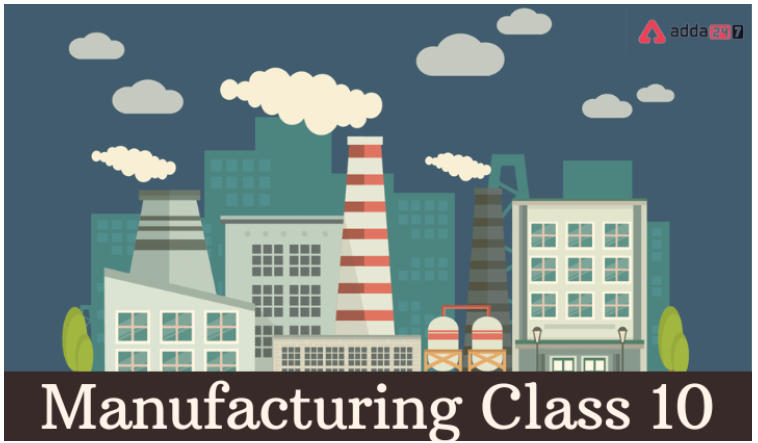What is Manufacturing?
Manufacturing is the process of producing items in large quantities from less valuable basic resources. Manufacturing is seen as a secondary activity since it transforms raw materials, such as cotton fibre, into completed things (like textiles)
Manufacturing Industries Importance
The manufacturing sector is considered the backbone of development due to the following reasons:
- Manufacturing industries help in modernising agriculture as it provides jobs in secondary and tertiary sectors.
- It helps in the eradication of unemployment and poverty.
- Export of manufactured goods expands trade and commerce, and brings in much needed foreign exchange.
- It helps in prospering the country by giving a boost to the economy.
- The manufacturing sector is regarded as the foundation of economic and general development because it aids in the modernisation of agriculture.
- By giving people jobs in the secondary and tertiary sectors, they lessen the population’s heavy reliance on agricultural income.
- Aids in the reduction of poverty and unemployment.
- Reduces regional imbalances by developing industries in tribal and underdeveloped regions.
- Exports of manufactured items boost business and trade while bringing in much-needed foreign currency.
- India must transform its raw materials into a wide range of finished items to thrive.
- Agriculture and industry work closely together. In the case of agro-industries, for instance, agriculture aids the industry by supplying raw materials, and the industry offers goods like irrigation pumps, fertilisers, insecticides, etc
- If the quality of our manufactured goods is comparable to that of imported goods, we can compete in global marketplaces.
Manufacturing Industries Contribution to the National Economy
- Over the past 20 years, the manufacturing sector’s percentage of the GDP (Gross Domestic Product) has remained constant at 17%.
- A total of 27% of the GDP is contributed by industry, of which 10% comes from mining, quarrying, power, and gas.
- The manufacturing sector had a 7% growth in the previous ten years. The annual growth rate has been between 9 and 10 per cent since 2003. The preferred growth rate for the upcoming ten years is 12%.
- The National Manufacturing Competitiveness Council (NMCC) was established with the goal of boosting productivity via the implementation of sound public policy and increased industrial activities.
The trend of growth rate in manufacturing over the last decade has been around 7 per cent per annum.
Industrial Location
Industrial locations are influenced by the availability of:
- Raw material
- Labour
- Capital
- Power
- Market
- Government policies
Manufacturing activity tends to locate at the most appropriate place where all the factors of industrial location are either available or can be arranged at a lower cost. The figure below shows the industry market linkage.
Agro-based Manufacturing Industries
Cotton, jute, silk, woollen textiles, sugar and edible oil, etc. industries are based on agricultural raw materials. Let’s know about each of them, one by one.
Textile Industry
It is the only industry in India, which is self-reliant and complete in the value chain i.e., from raw material to the highest value added products. It contributes to industrial production, employment generation and foreign exchange earnings.
Cotton Textiles
This industry has close links with agriculture and provides a living to farmers, cotton boll pluckers and workers engaged in ginning, spinning, weaving, dyeing, designing, packaging, tailoring and sewing. It supports many other industries, such as, chemicals and dyes, packaging materials and engineering works.
Jute Textiles
India is the largest producer of raw jute and jute goods. Most of the mills are located in West Bengal, mainly along the banks of the Hugli river.
Sugar Industry
India stands second as a world producer of sugar but occupies the first place in the production of Gur and Khandsari. This industry is seasonal in nature.
Mineral-based Manufacturing Industries
Industries that use minerals and metals as raw materials are called mineral-based industries. Let’s discuss some industries that fall under this category.
Iron and Steel Industry
Iron and steel is the basic industry as all the other industries – heavy, medium and light, depend on it for their machinery. lt is considered as a heavy industry because all the raw materials, as well as finished goods, are heavy and bulky entailing heavy transportation costs.
India is an important iron and steel producing country in the world yet, we are not able to perform to our full potential largely due to:
- High costs and limited availability of coking coal
- Lower productivity of labour
- Irregular supply of energy
- Poor infrastructure.
Aluminium Smelting
Aluminium Smelting is the second most important metallurgical industry in India. It is used to manufacture aircraft, utensils and wires. Bauxite is the raw material used in the smelters.
Aluminium Smelting has gained popularity as a substitute for steel, copper, zinc and lead in a number of industries. It exhibits the following properties:
- Light in weight
- Resistant to corrosion
- A good conductor of heat
- Malleable
- Becomes strong when it is mixed with other metals
Chemical Industries
The Chemical industry comprises both large and small scale manufacturing units. Rapid
growth has been recorded in both inorganic and organic sectors.
Inorganic chemicals include sulphuric acid nitric acid, alkalies, soda ash and caustic soda.
Organic chemicals include petrochemicals, which are used for manufacturing synthetic fibers, synthetic rubber, plastics, dye-stuffs, drugs and pharmaceuticals.
Fertilizer Industry
The fertilizer industries are centred around the production of nitrogenous fertilizers (mainly urea), phosphatic fertilizers and ammonium phosphate (DAP) and complex fertilizers which have a combination of nitrogen (N), phosphate (P), and potash (K). Gujarat, Tamil Nadu, Uttar Pradesh, Punjab and Kerala contribute towards half of the fertilizer production.
Cement Industry
Cement is essential for construction activity such as building houses, factories, bridges, roads, airports, dams and for other commercial establishments. This industry requires bulky and heavy raw materials like limestone, silica and gypsum.
Automobile Industry
This industry deals with the manufacturing of trucks, buses, cars, motorcycles, scooters, three-wheelers and multi-utility vehicles. These industries are located around Delhi, Gurugram, Mumbai, Pune, Chennai, Kolkata, Lucknow, Indore, Hyderabad, Jamshedpur and Bengaluru.
Information Technology and Electronics Industry
The electronics industry covers a wide range of products from transistor sets to television, telephones, cellular telecom, telephone exchange, radars, computers and many other equipment required by the telecommunication industry. This industry has generated employment in India. Bengaluru is known as the electronic capital of India.
Manufacturing Industries Pollution and Environmental Degradation
Industries are responsible for 4 types of pollution:
- Air
- Water
- Land
- Noise
Air pollution is caused by the presence of a high proportion of undesirable gases, such as sulphur dioxide and carbon monoxide. Smoke is emitted by chemical and paper factories, brick kilns, refineries and smelting plants, and burning of fossil fuels leads to air pollution. It adversely affects human health, animals, plants, buildings and the atmosphere as a whole.
Water pollution is caused by organic and inorganic industrial wastes and effluents discharged into rivers. The industries which are mainly responsible for water pollution are paper, pulp, chemical, textile and dyeing, petroleum refineries, tanneries and electroplating industries.
Thermal pollution of water occurs when hot water from factories and thermal plants is drained into rivers and ponds before cooling.
Noise pollution is the propagation of noise with harmful impact on the activity of human or animal life. It results in irritation, anger, causing hearing impairment, increased heart rate and blood pressure.
Control of Environmental Degradation form Manufacturing Industries
Here are some ways through which industrial pollution can be reduced:
- Minimising the use of water by reusing and recycling it.
- Harvesting rainwater to meet water requirements.
- Treating hot water and effluents before releasing them in rivers and ponds.
- Particulate matter in the air can be reduced by fitting smoke stacks to factories with electrostatic precipitators, fabric filters, scrubbers and inertial separators.
- Smoke can be reduced by using oil or gas instead of coal in factories.
- Machinery can be redesigned to increase energy efficiency and reduce noise.
Manufacturing Industries- Classification
- Depends on the type of raw materials used: mineral- and agricultural-based.
- Cotton, wool, jute, silk textiles, rubber, sugar, tea, and coffee are examples of agro-based industries.
- Iron, steel, cement, aluminium, petrochemicals, and other industries are minerals-based.
- Based on the Basic and Consumer industries’ primary functions.
- Basic or Key Industries: These sectors provide the products or raw materials used in the production of other items. Examples include the production of iron and steel, copper smelting, and aluminium smelting.
- Consumer industries: These sectors create products that customers use directly, such as sugar, paper, electronics, soap, etc.
- Small- and large-scale enterprises are based on capital investment
- Small Scale Industry: An industry is referred to as small scale if the invested capital is less than one crore.
- Large Scale Industry: An industry is referred to as being on a large scale if it has more than one dollar invested.
- According to who owns what: public, private, cooperative, and joint sectors.
- Public Sector: Government organisations, such as SAIL, BHEL, and ONGC, own and run these businesses.
- Private Sector: Companies like TISCO, Reliance, Mahindra, etc., are owned and run by a single person or a small group of people.
- Joint Sector: These businesses are held equally by the government and one or more private parties, such as Oil India Limited.
- Based on the size and weight of the finished products and the raw materials — Heavy industries, Light
- Heavy industries manufacture capital goods like automobiles and construction equipment using huge machinery and bulky or heavy raw materials. For instance: the iron and steel sector.
- Light industries are those that utilise light raw materials to make light utility goods, such as the electrical and toy industries.
Manufacturing Industries Class 10 Notes Questions and Answers
Question 1.
What is manufacturing? To which sector of economy does it belong?
Or
“The economic strength of a country is measured by the development of manufacturing industries”. Support the statement with arguments. (2016 D)
Ans. Manufacturing. Production of goods in large quantities after processing from raw materials to more valuable products is called manufacturing.
Manufacturing belongs to the secondary sector in which the primary materials are processed and converted into finished goods. The economic strength of a country is measured by the development of manufacturing industries.
Question 2. Write about the importance of the ‘manufacturing sector’ for our nation.
Or, “Manufacturing industry is considered the backbone of economic development of India.” Give reasons. (2015 OD, 2011 D)
Ans. Importance of manufacturing industries for India:
- It helps in modernizing agriculture, which is the base of our economy.
- It reduces heavy dependence on agricultural income by providing jobs in non-agricultural sectors.
- Industrial development is necessary for eradication of poverty and unemployment because people get jobs and generate more income.
- Export of manufactured goods expands trade and brings in much needed foreign exchange.
- Industries bring riches faster to a nation because manufacturing changes raw materials into finished goods of a higher value, so industrial development brings prosperity to the country.
Question 3 “Agriculture and industry are not exclusive of each other, but move hand in hand.” Give arguments in favour of this statement. (2013 D)
Or, Explain with examples how industries in India have given a major boost to agriculture. (2015 D, 2012 OD)
Ans. Agriculture and industry in India are inseparable or interdependent on each other:
- Agro-industries in India have boosted agriculture by raising its productivity.
- Industries depend on agriculture for their raw materials, e.g. cotton textile industry.
- Industries provide many agricultural inputs like irrigation pumps, fertilisers, insecticides, PVC pipes, machines and tools etc. to the farmers.
- Manufacturing industries have assisted agriculturists to increase their production and also made the production processes very efficient.
- Development of different modes of transport by the industrial sector has not only helped farmers to obtain agricultural inputs but has also helped them trade their products.
Question 4 Write the contribution and present growth rate of the manufacturing sector in the national economy. Suggest measures to increase the industrial growth rate. (2011 OD)
Ans. The share of the manufacturing sector has stagnated at 17% of GDP. The trend of growth rate over the last decade has been around 7% per annum. Since 2003, it has shown an increased growth rate of 9-10% per annum. The desired growth rate over the next decade is 12%. To attain this target, following steps can be taken:
- Appropriate policy interventions by the government.
- Renewed efforts by the industries to improve productivity.
Question 5 List the major factors which affect the location of an industry at a place. What is the key to the decision of ‘factory location’? (2011 D, 2011 OD, 2015 D)
Ans. Raw material. Cheap and abundant availability of raw material. Industries which use heavy and perishable raw material have to be located close to the source of raw material.
- Labour. Availability of cheap labour is necessary for keeping the cost of production low.
- Power. Cheap and continuous supply of power is extremely necessary for continuity in the production process.
- Capital. It is necessary for developing infrastructure, for the entire manufacturing process and for meeting manufacturing expenditure.
- Banking and insurance facilities, favourable government policies are other factors which affect location of an industry.
The ‘key’ to the decision of a factory location is least cost so that the venture is profitable.
Question 6 “Industrialisation and urbanisation go hand in hand.” Explain.
Ans. After industrial activity starts, urbanisation follows. Some industries are located in and around the cities. Thus industrialisation and urbanisation go hand in hand. Cities provide markets, services such as banking, insurance, transport, labour, consultants and financial advice, etc. to industries.
Question 7 What are ‘agglomeration economies’ in the industrial context?
Ans. Many industries tend to come together to make use of the advantages offered by the urban centres known as ‘agglomeration economies’. Gradually, a large industrial agglomeration or clustering takes place around an urban centre.
Question 8 State any five basis on which industries are classified.
Ans.
- On the basis of the source of raw materials used — Agro-based and mineral-based.
- According to their main role — Basic and Consumer industries.
- On the basis of capital investment—Small-scale and large-scale industries.
- On the basis of ownership — Public Sector, Private Sector, Cooperative Sector, Joint Sector.
- Based on the bulk and weight of raw material and finished goods—Heavy industries, Light industries.
Question 9 Classify industries on the basis of capital investment. How are they different from one another? Explain with examples. (2016 D)
Ans. On the basis of capital investment industries can be classified as:
- Small-scale industry
- Large-scale industry
Question 10 Classify industries on the basis of source of raw material. How are they different from each other? (2016 OD)
Ans. On the basis of sources of raw material industries are classified as:
(i) Agro based industries;
(ii) Mineral based industries
Difference between Agro-based industries and Mineral-based industries
| Agro-based industries | Mineral-based industries |
| They obtain their raw materials from agricultural products.
Example: Textiles —cotton, jute, silk and woolen. Rubber, Sugar, Coffee, Tea and Edible Oil, etc. |
They obtain their raw materials from minerals. Example: Iron and steel, cement, machine tools, petro-chemicals, etc. |
Question 11. List the locations of the majority of manufacturing facilities prior to independence.
Answer- Mumbai, Kolkata, and Chennai.
Question 12. What are the criteria for an optimal industrial location? Name anyone.
Answer- Availability of raw materials is the answer.
Question 13. Identify two agro-based industries.
Answer- cotton and woollen textiles Industry
Question 14. “Agriculture and industry are complementary to one another”. Describe with examples.
Or
How do businesses support the agricultural sector?
Answer-It is accurate to say that industry and agriculture coexist.
Agro-based businesses like cotton, woollen, jute and edible oil rely on agriculture for their basic resources.
In exchange, these businesses sell farmers irrigation pumps, fertiliser, pesticides, PVC pipes, and a variety of other goods.
As a result, agro-industries have increased agriculture’s output and improved the efficiency of its production methods.
Question 15. Where in the pre-independence era where the majority of the manufacturing facilities located? What was the outcome?
Answer- Before independence, manufacturing facilities were positioned with international trade. Chennai, Kolkata, and Mumbai were among these locations.
Result: As a result of the manufacturing sectors being located in Mumbai, Kolkata, Chennai, and other locations, certain pockets of industrially developed metropolitan centres with a sizable agricultural and rural hinterland have emerged.
In Mumbai, the first cotton textile mill was built in 1854.
In 1859, the first jute mill was built in Rishra, a town close to Kolkata.
Question 16. Describe the iron and steel industry in terms of its characteristics, applications, and production process.
Answer- (1) Basic industry: The iron and steel sector is fundamental since it provides the machinery for all other sectors of the economy.
(2) Production and heavy industry: The heavy industry requires expensive transportation due to the weight and bulk of all the raw materials and final goods.
Limestone, coking coal, and iron ore are needed in an approximate 4:2:1 ratio.
(3) To harden the steel, some manganese is also necessary. Steel is used to make a wide range of engineering products, building materials, defence, medical, telecommunication, scientific equipment, and consumer goods.









 NIOS 10th Result 2025 Out @results.nios....
NIOS 10th Result 2025 Out @results.nios....
 Mahatma Gandhi Central University CUET C...
Mahatma Gandhi Central University CUET C...
 CUET BBAU Cutoff 2025, Check Category Wi...
CUET BBAU Cutoff 2025, Check Category Wi...

